Jemi Gale: donut king (paintings about love)
Audrey Pfister
My brother once told me that if he goes anywhere where there are donuts, he will always buy one. It’s a literal sweet indulgence. donuts, in this scenario, are a charm: they not only allure, but they’re also ritualistic or a token of good luck. This process—the transmutation of mass-produced goods into objects of personal pleasure and charm—is made manifest in Jemi Gale’s new body of work donut king (paintings about love). Here, donuts are objects of, but also metaphors for a mode of sugary, hyperactive consumption, and the minor pleasures that accompany it: love and loving, desire, and indulgence.
6 cinnamon donuts
strawberry milkshake please
happy smiles factory
it’s a share in a dream
nothing can hurt us
pure light source energy
-Jemi Gale, extract from poem accompanying the work you look like when the sky looks pretty, 2022
Gale’s donut king (paintings about love) was exhibited from the 10th to the 12th of June at Suite7a, currently located in Potts Point (works in store available to view via appointment). Suite7a avoids easy categorisation. Although they began as a studio in Darlinghurst, their priority is to “change as we learn”, and they now seem to operate mostly as a kind of artist-run, reasonably affordable, art store that prioritises the independence and autonomy of artists. The predominant option for unsigned artists exhibiting in Sydney is to pay a significant space hire fee at an ARI—Suite7a, in a transparent and malleable way, offers an alternative.

While the focus of the exhibition is Gale’s collection of five paintings and poems, the artist also invited her friends Brayden Van Meurs, Jess Tan, Jennifer Matthews, Luyuan Zhang and Jackie De Lacy to contribute works. After buzzing into the art deco building and climbing the stars, I immediately notice a spinning work of satin ribbons strewn from a twirling ceiling fan. Beau Blue ribbons spiral and whirl like a dancer or maybe a slow motion cyclone. It’s a work by Jackie de Lacy titled Everyday, I Don’t (2022) in reference to an Anna Domino song of the same name. Printed on the ribbon are the opening lyrics “Every day, I say that I won’t, and I don’t”. This is a declaration of non-disclosure and protection. Importantly, Jackie has noted that for her it’s also become an emblem of perseverance in the face of grief, scrutiny or pain. It brings to mind the words of the musician Terre Thaemlitz who in their ‘Naisho Wave Manifesto’ reminds us of “the value of secrets, their protective power and their ability to connect people in deep ways through the cultivation of personally affecting social responsibilities”. Everyday, I Don’t is like a charm—a small protective spell. Jackie has always liked charms. I know this because she has given me charms before (a small plaster off-cut that reads “take care”). The one hundred metres of satin ribbon has been cut into strips for people to purchase and have as their own trinket of perseverance, or to feel “beautiful if you were to wear it”.

Jackie’s work spins on top of Gale’s painting forever + ever (2022). It’s pleasantly confusing where one artist’s work begins and ends—Jackie’s work spinning on top of, into, onto, out off, Gale’s painting. I never really imagined art as made by a singular author anyway—art is always interfacing with friendship, histories, and various contingencies. All the artists in this show revolve around a shared visual language, perhaps what Cameron Hurst termed the “grotty (girl)” trend; that is, art that involves a material taxonomy of loose coloured pencil, rough paint, collage, miniature plastic objects, and an overall grimy aesthetic with a touch of the saccharine. In this vein, Gale and friends’ style is quite decorative, DIY and scrapy as it refrains from traditional fine art forms, and often highlights both the playfulness of detritus, and mass materials and imagery.
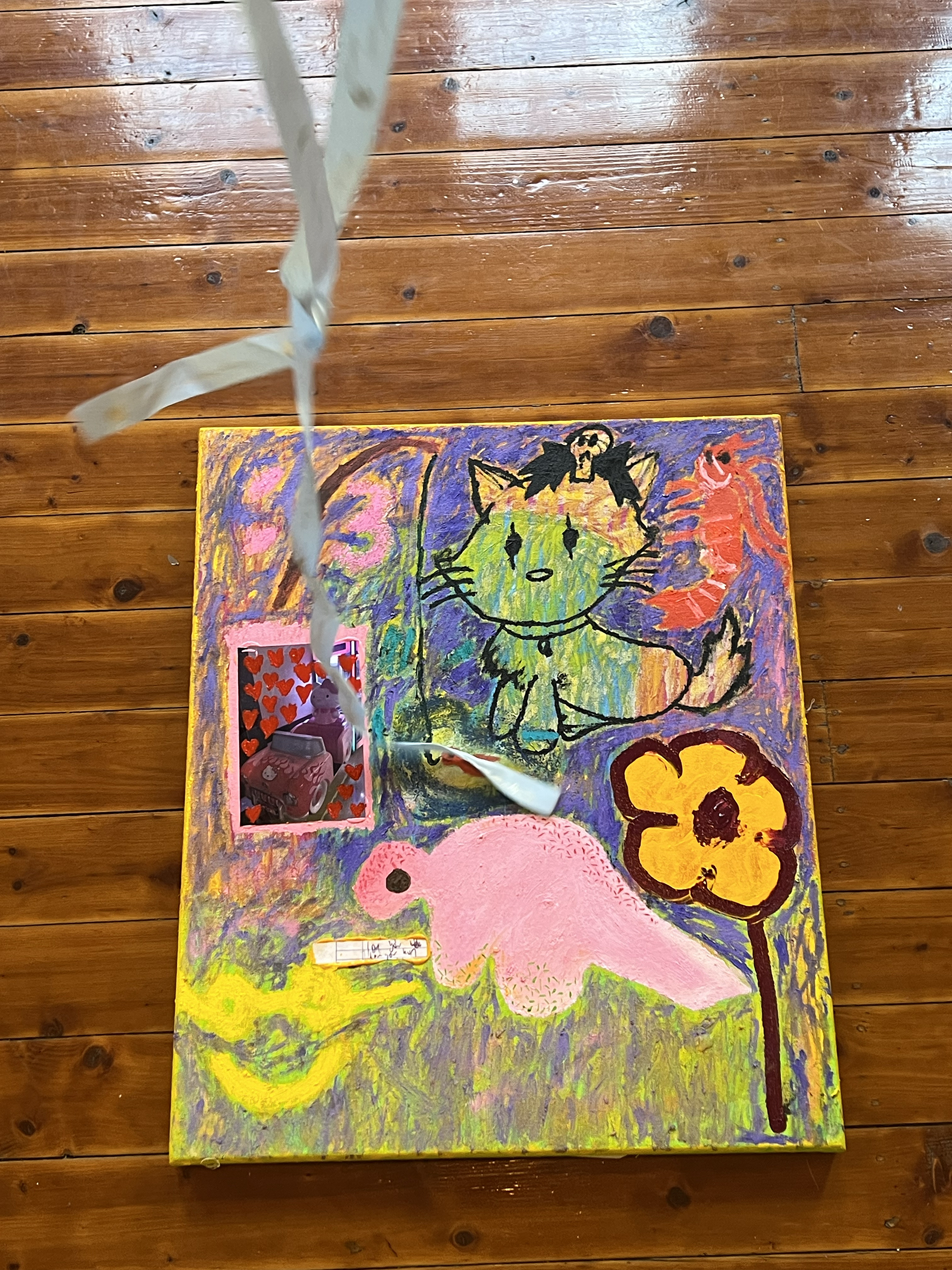
Forever + ever shows a cat, a crustacean, a fishing rod and fish, a flower, a smiley, and a collaged image of a coin-operated Hello Kitty kids’ ride that is eerily nostalgic of suburban shopping centres. Like a dreamscape, painterly purples, pinks, greens and yellows all swim together—the arrangement is sweet and light, and lacking any sense of rigidity. Gale’s lightness and visual nostalgia seems to be honest in presenting a kind of vital joy in response to the emotional weight and commodification of everyday life. One painting from Gale sits in the studio window; it’s daytime so the sun is shining through the back of the canvas, giving the blue an unnatural glow. The work, the only way out is through / and all i want is you (heart practice) (2022), uses acrylic, oil paint, nail polish, spray paint, collage, charms, silk, and a poem which asks: “What colour is love”? I normally struggle to connect with most paintings, but Gale makes it easy.
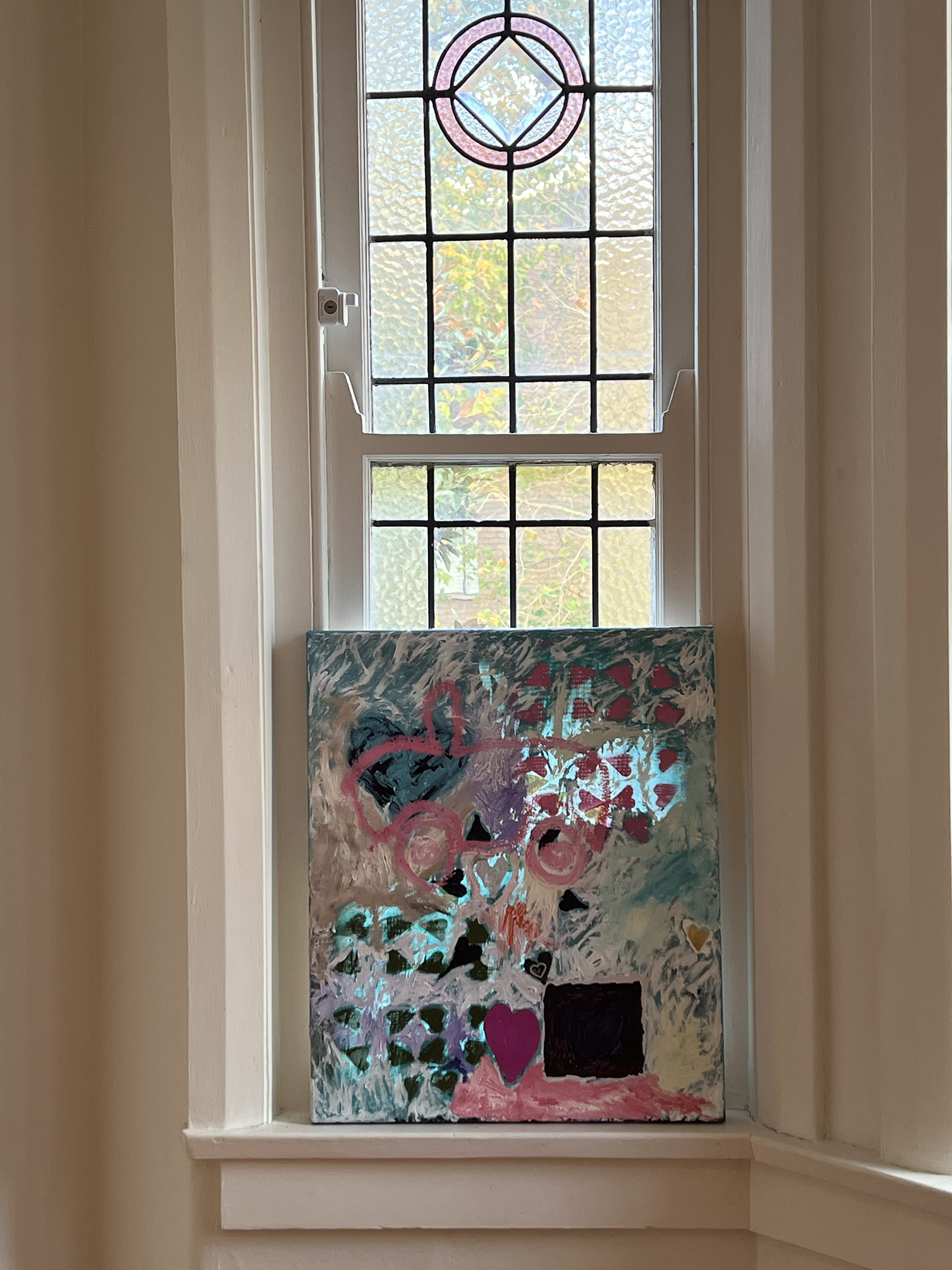

All of Gale’s paintings are like this. You look like when the sky looks pretty (2022) is roughly brushed with a figurative pink spiral, and collaged in is the word “LOVE” and a cartoon animal. Another painting sits in the studio kitchen, the cupboard opening up around it. This painting is mostly pink with large black and white thick messy strokes and layers. It depicts a hotdog stick, a panda, abstract lines suggesting a hamburger, and the words “I can’t remember anything except I love you”. Gale’s works seem to position sweet and popular foods like donuts and burgers as not just objects of consumption, but as metaphors for the process of consumption itself. Gale’s paintings have a kind of bedroom-pop music sensibility with their romanticism and the owning of aesthetic and narrative vulnerabilities. As her bio states, Gale “is an artist and a pop girl. She makes paintings about love”.
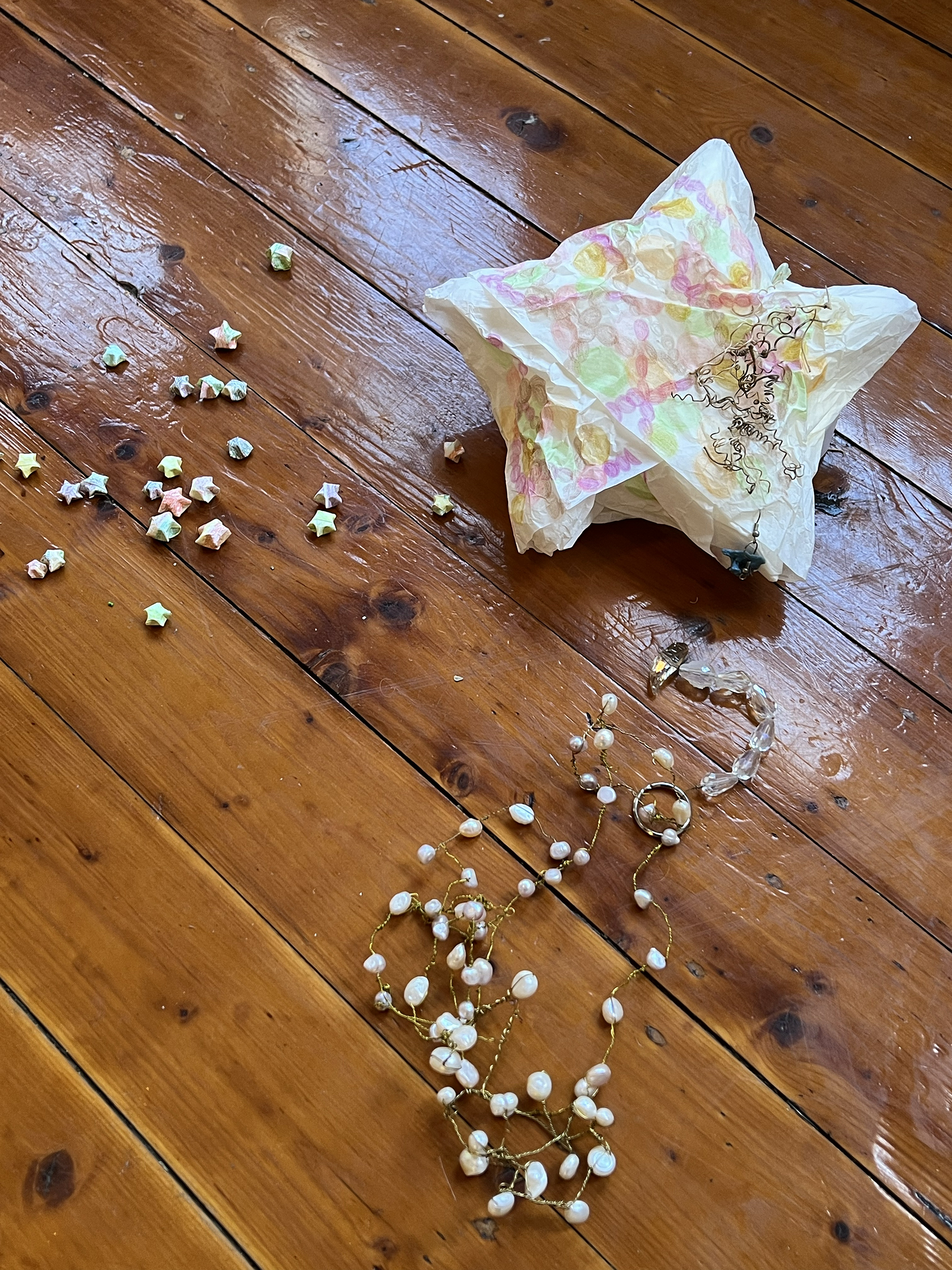
Sitting on the floor is Tan’s work Bubbles…droppings…dropping (2022), comprising a sculpted star (that lights up) and many smaller, tiny coloured baking paper stars, charms, beading wire and pearls (both real and fake). Tan’s work swallows mass-produced commodities like baking paper, plastic trinkets and symbols like stars, and brings them new life as playful, curious small sculptures to be exhibited and admired with friends. Tan’s bio states that she is interested in the life cycles of materials as they move through processes similar to that of a digestive tract. Immediately I think of Astrid Lorange, a friend and teacher, who once excitingly recounted how she read about the space between the mouth and anus as being a continuation of public space as the body opens to the outside world: “Our bodies,” Lorange has noted, “are hollow like a donut”. This exhibition similarly reminds us that affects like joy, desire, friendship, and love don’t emanate solely from within us, but rather move between and through our bodies in an ouroboric, doughtnut-like, manner.
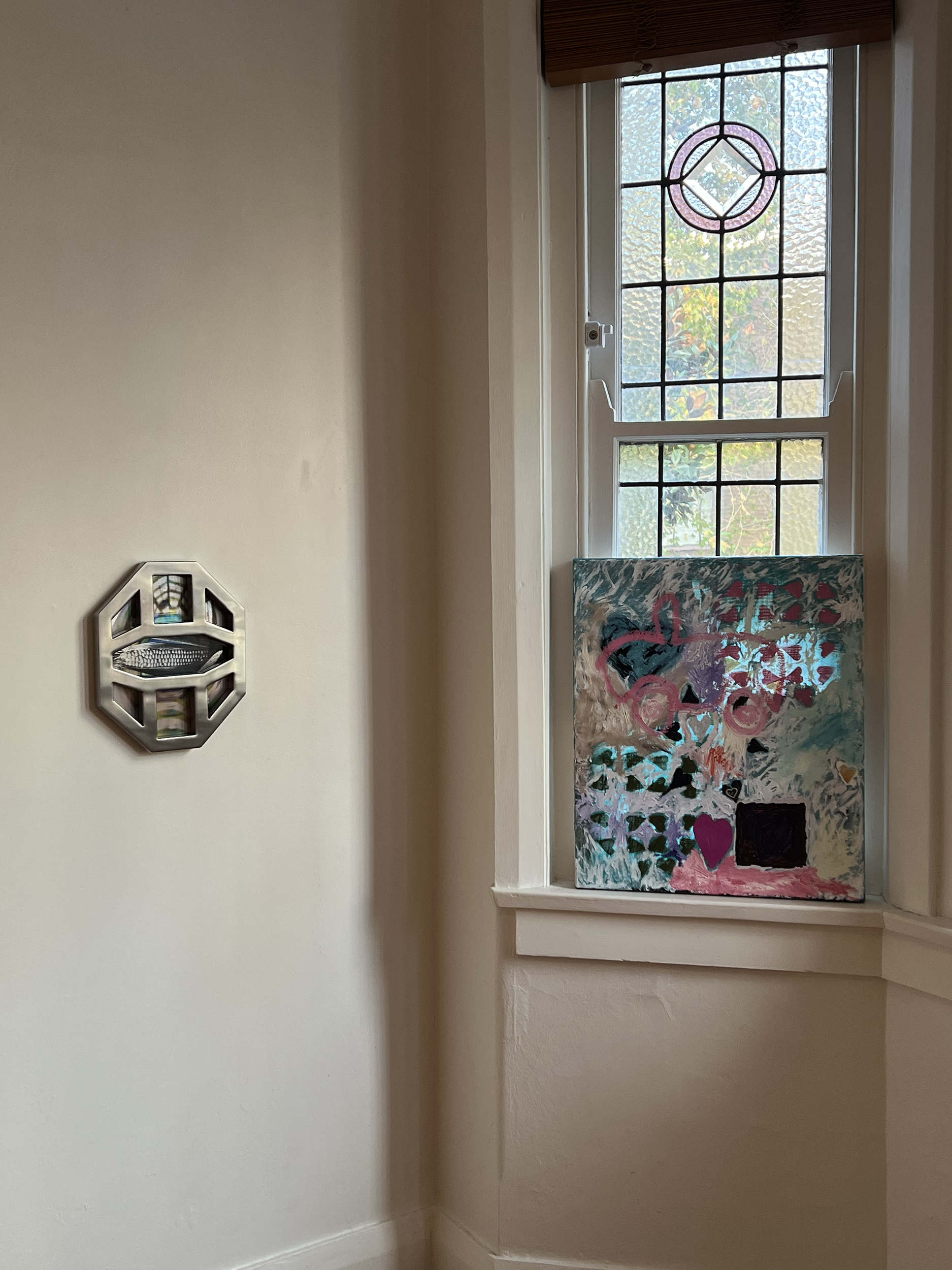
In the corner of a wall sits a small work by Jennifer Matthews. Maize (2022) is a stainless steel and transparent print featuring a corn cob that gestures towards the everyday industrial and agricultural. Although it seems familial at first glance, Maize looks almost like a sci-fi or psychedelic adaptation of our built environments. Maize is more polished, refined, and sleek than many of the other works in the exhibition, but it still speaks to similar themes. I think about how corn is a plant and food-source that is a human invention, and that does not and could not exist naturally in the wild. Corn sits at the centre of histories, anxieties and conspiracies. Traces of corn are found in everything from fructose corn syrup to erythritol, xylitol, animal feed, citric acid, fuel (ethanol)—an unavoidable human invention. If donuts are the symbol for desire and pleasure, maybe corn represents the flip-side: labour. Our labour turns into food which turns into energy and labour again.
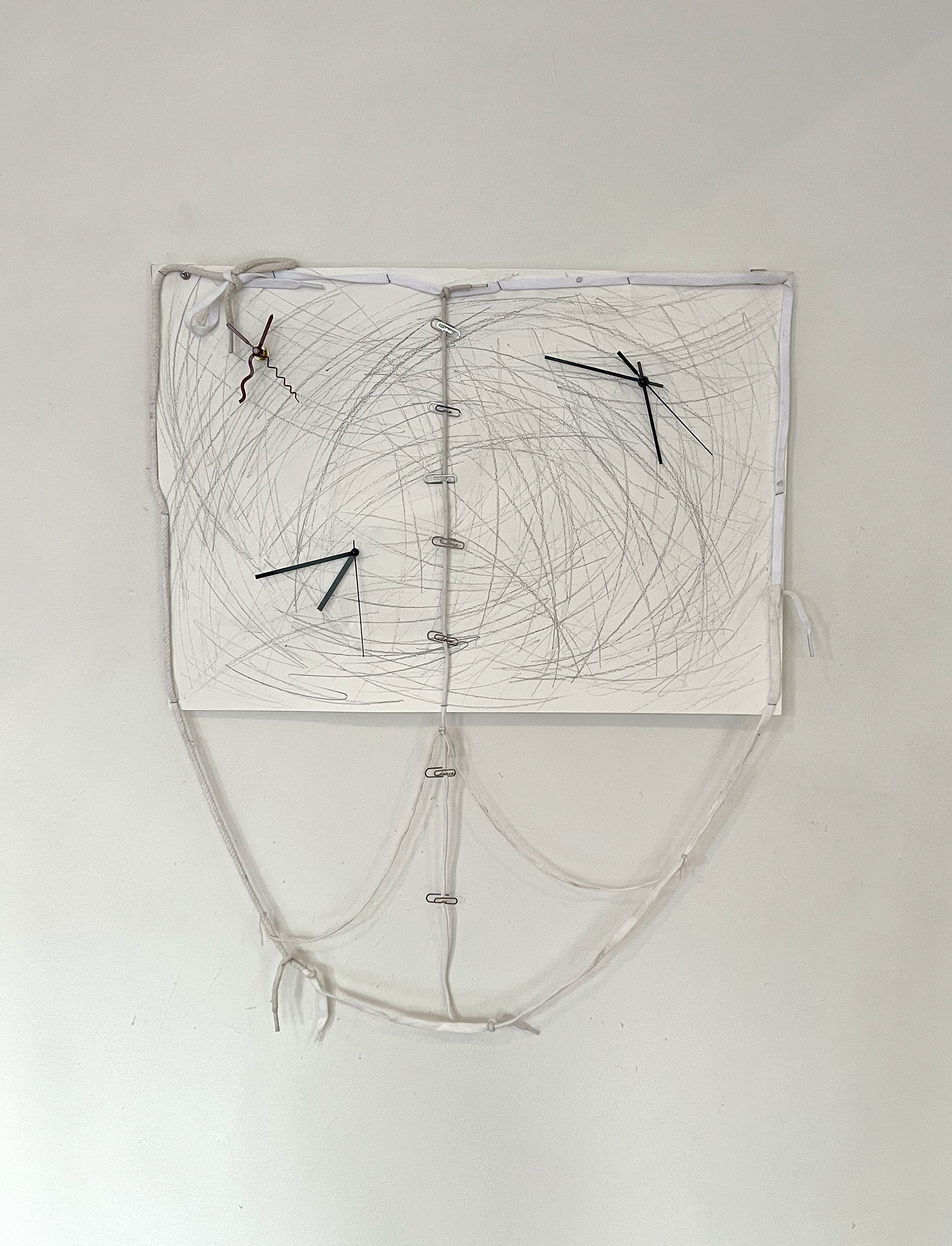
In the corner sits Brayden’s work I can’t afford to visit Paris yet. My imagination, however, can take me anywhere. Thank you for this <3 (2022) which ticks away on the wall with its three clock hands winding round on scribbled paper. The work is framed with shoelaces and strung with paperclips each with a word on them “You / Me / One / Hug / Love / Dance / Us”, each paperclip its own charm. And behind the door hides Luyuan’s ceramic Material Girl, a small figurine who’s arms loop around her side, while her hands frame her face. The artwork materials are listed: “Materials: love, earthenware clay, various glaze”. If the exhibition’s repeated signification of such words—dance, love, hug—are reminiscent of “live, laugh, love” dollar-store home decorations, that’s almost precisely the point. The artists consume the mass empty signifiers of mass commodification and capital, digesting it into remade charms of genuine, playful, silly love and secret intimacies.
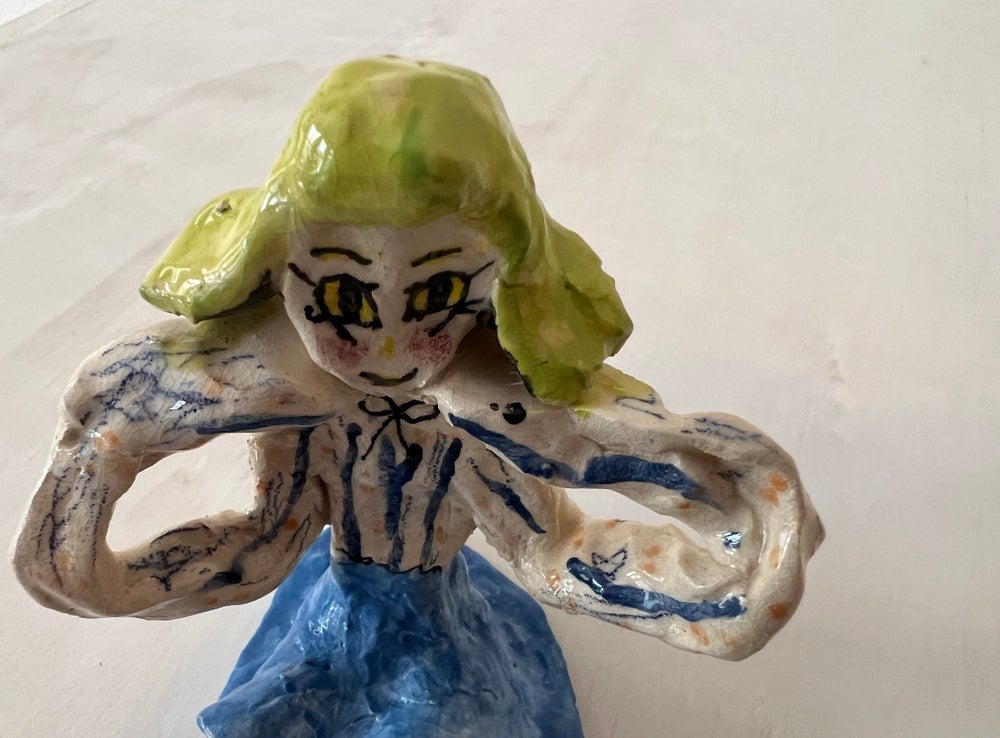
I leave the exhibition excited to see a show in Eora/Sydney that is entangled with friendship and desire, in a city where it feels cringe to make work such work when the majority of artists are coming out from expensive art schools that either prioritise the traditional fine arts masculine genius (National Art School) or the highly intellectualised artist/designer (UNSW Arts, Design and Architecture). However, if the last few years have demonstrated anything it is that artists in Sydney are embracing (queer) friendship and love, as seen with recent shows like Olga Svyatova’s Philia at Tiles Lewisham or Ava Lacoon-Robinson and Joshua di Mattina-Beven Love Letters to the Horizon at Backspace. In part, because this is just our lives (duh) but also because we know what it’s like to feel the flip side—pain and grief—and we want to protect against that. Although donut king, Philia, and Love Letters to the Horizon have all in some way been implicitly or explicitly about desire, friendship, and love, their approaches are all significantly different.

Understanding the donut as a metaphor of consumption we better see the importance of protection and perseverance against the outside (“Everyday I don’t”) and the importance of embracing the outside of friendship and community (“You / Me / One / Hug”). Gale’s embrace of sugary, pop, “grotty” aesthetics tries to hold understand love but not capture it, she lets it run wild, and runs with it. One poem from Gale begins with “you’re doing burnouts in my brain / love as fast as you drive your car / left handed scissors / love is an addiction”. I imagine a car doing donuts aka burnouts in my head and right now I can’t imagine a better way to describe crushing, loving, obsessing, and desiring.
Audrey Pfister (sometimes-) writes, edits, Djs, and works in the arts on Gadigal and Thawaral lands. They have a Bachelor of Art Theory and First Class Honours in Arts (Media, Culture, Technology). Lately they’ve been writing a lot about art, love, and friendship, but they swear they can write funny and/or serious pieces too.


